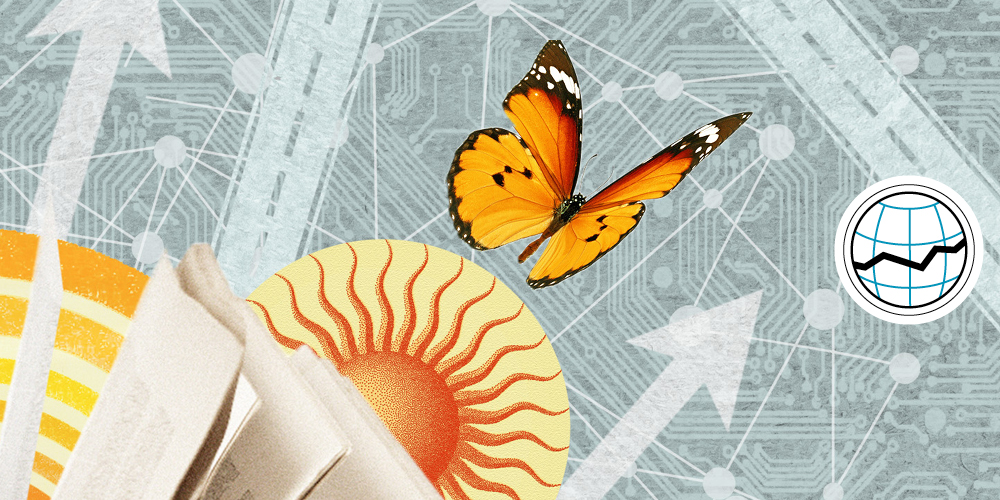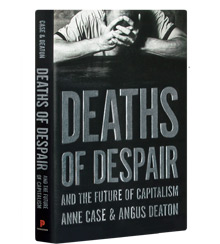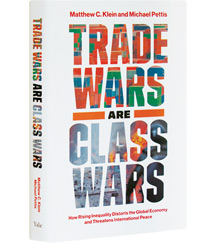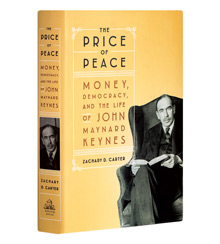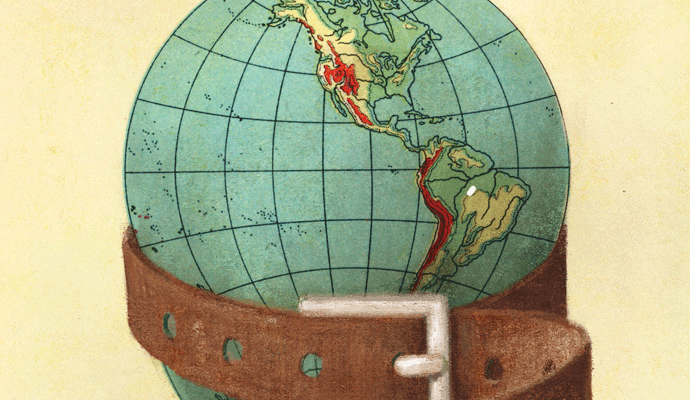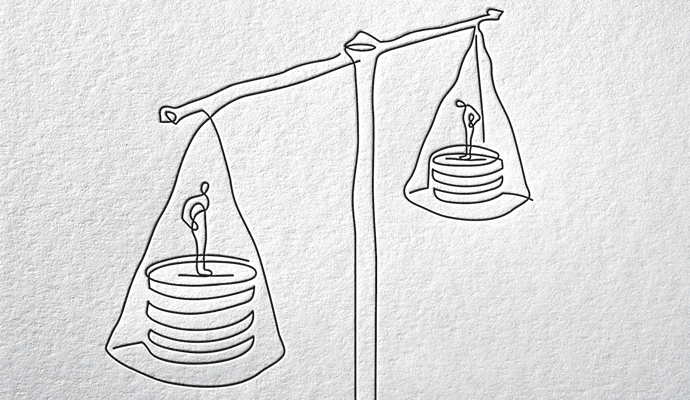Best Business Books 2020: Economics
A master class in conflicts
Anne Case and Angus Deaton
Deaths of Despair and the Future of Capitalism (Princeton University Press, 2020)
Matthew C. Klein and Michael Pettis
Trade Wars Are Class Wars: How Rising Inequality Distorts the Global Economy and Threatens International Peace (Yale University Press, 2020)
Zachary D. Carter
The Price of Peace: Money, Democracy, and the Life of John Maynard Keynes (Random House, 2020)
*A TOP SHELF PICK
As wild as current economic events have been, as challenging to conventional wisdom and orthodox thinking as they have proved, the COVID-19 pandemic and its associated hardships have left the world grasping anew for understanding. This bracing experience will have a powerful intellectual legacy: more profound, one supposes, than even that of the global financial crisis. Stuck inside, with hours available to read, we can take some small comfort in the fact that the still-boiling economic arguments of the past decade continue to provide us with new books, including some with quite a lot to say about our present circumstances. This year’s three best business books on economics revolve around the ways in which economic developments have led to social, trade, and political clashes. They are: a treatise that plumbs the depths of the U.S. opioid crisis, a sharp and brief argument about how inequality leads to trade wars, and, the best of the group, a fantastic biography of the 20th century’s most well-known economist, John Maynard Keynes.
In 2015, two eminent economists, Anne Case and Nobel Prize winner Angus Deaton (who are married), began presenting joint research on what they would eventually dub “deaths of despair”: those caused by suicide, drug overdoses, and alcohol abuse. Their book on the topic, Deaths of Despair and the Future of Capitalism, is a meticulous forensic analysis of several deeply disconcerting trends in U.S. mortality. In 2017, they write, 158,000 Americans died from the causes they study. It is a staggering figure — or it would be, if COVID-19 had not already claimed the lives of roughly 200,000 people in the United States by September 2020. Yet the book feels no less urgent. Case and Deaton connect deaths of despair to a variety of social pathologies. Those same pathologies have helped make 2020 the tragic and distressing year it has become.
A stark finding lies at the heart of their thesis. The number of expected years of life at birth has risen in the U.S. more or less constantly since records have been kept, thanks to rising incomes, medical advances, and broader improvements in public health. Yet between 2014 and 2017, life expectancy across the U.S. population as a whole declined. Only once before, as far as records indicate, had that happened — during the late 1910s, when war and pandemic influenza made their lethal mark.
The toll has not been distributed evenly. Middle-aged, non-Hispanic whites, especially those without a college degree, have borne the brunt of the hardship in the United States. The country’s opioid epidemic deserves a large share of the immediate blame. It initially battered blue-collar towns and rural areas. As measures were taken to choke off the flow of prescription drugs, addicts increasingly turned to illegal substitutes such as heroin and fentanyl, and use and abuse became more widespread. But deaths attributable to alcohol and other drugs showed a meaningful increase as well, as did suicides.
As the authors demonstrate, there is no simple connection between deaths of despair and poverty, inequality, or the hardship associated with the global financial crisis. Instead, they argue provocatively but compellingly, the phenomenon is best understood as being rooted in a social breakdown. One clue is the diverging experiences of those with and without college degrees. Middle-income jobs in factories and offices have been destroyed by automation and trade. Wages, adjusted for inflation, have grown pitifully slowly for such people, while rates of labor-force participation have declined. These trends seem to have taken a particular psychological toll on white non-Hispanics.
But deaths of despair reflect more than mere economic hardship, say Case and Deaton. Lost jobs often translate into declining communities, and worsening social prospects for those living in such communities. Marriage rates among the hardest-hit demographic groups have fallen, as have attendance at religious services and involvement in community activities. Meanwhile, the authors argue, those left behind by economic and social change have been preyed upon by profit-hungry corporations in uncompetitive industries that (protected by patent rights, friendly regulation, and lax antitrust rules) have lined the pockets of their executives and white-collar staff while ignoring the collateral damage inflicted on individuals and communities.
These same social pathologies have also undermined the nation’s effort to control COVID-19, and to hold together as a society while suffering through it. But the policy proposals the authors offer toward the book’s end — investments in education, efforts to make markets more competitive, and higher minimum wages — feel like weak tea after the damning portrait they have painted of a society content to let communities collapse and citizens die of their misery.
Exporting conflict
The subject of Trade Wars Are Class Wars: How Rising Inequality Distorts the Global Economy and Threatens International Peace is far broader than that of Deaths of Despair, taking in the whole of the global economy. Matthew C. Klein, an economics writer for Barron’s (and a former colleague of this reviewer) and Michael Pettis, a professor of finance at Peking University in Beijing, pack into just a few hundred pages a sweeping and powerful account of the interconnections between cutthroat politics and global economic imbalances.
The world, both before the pandemic and now, was divided by battles over trade — most notably the intensifying conflict between the U.S. and China. Differences between feuding countries, in their political and value systems, for instance, explain some of this sparring. Klein and Pettis demonstrate, though, that political fights within countries are a more fundamental cause of many trade battles. The world’s monetary system transforms domestic class wars into trade conflicts, and as it does, it moves the world closer to financial breakdown and geopolitical hostility.
The book, at 288 pages, covers a remarkable amount of material in what is essentially an afternoon read. Klein and Pettis quickly but effectively guide their audience through several hundred years of history as they demonstrate the shortcomings of many conventional ways of thinking about trade and global finance. Classical economists such as Adam Smith and David Ricardo viewed trade as being determined by countries’ comparative advantages. Most global financial flows, in turn, were associated with the direct finance of exchanges of goods and services, and were correspondingly quite small relative to the size of the global economy. In 1855, Klein and Pettis estimate, the total value of all cross-border financial claims was only about 16 percent of global annual GDP. Global commerce today looks very different, and is less clearly a social good. Cross-border financial claims now amount to about 400 percent of global GDP. Financial flows occur as investors chase returns around the world, and trade imbalances are formed under the pressure of these torrents of money. Domestic politicians struggle to correct economic imbalances rooted within their country.
The headaches all begin with the distribution of income. The richer a household is, the more of its income it is able to save. Places with relatively flat income distributions can therefore support plenty of domestic consumption, bolstering the sales volume of domestic firms and encouraging them to invest more. In unequal countries, on the other hand, the savings of the rich pile up. Domestic investment slumps, because cash-strapped consumers make for an unappealing growth market. In an open economy, the rich can look abroad for places to invest, and the domestic productive capacity that might otherwise fill the homes of thriving workers is instead used to make goods for export markets. And so, the result of unresolved domestic class conflict is a trade surplus. Other countries, then, are left to import the political disharmony in the form of a flood of unmanageable capital that may trigger bubbles and subsequent crashes and a deluge of imports that threaten domestic livelihoods.
Germany in the early 2000s sought to address problems of chronically high unemployment by slashing workers’ wages and weakening the social safety net. German officials argue that this restored firms’ competitiveness, turning them into export juggernauts and engines of job creation. Klein and Pettis tell a different story: The squeeze on workers both dented domestic consumption and raised corporate profits, putting more money in the hands of wealthy Germans. Excess production flowed abroad, adding to the surplus. The savings of the rich departed, too, pouring money into southern Europe and helping inflate massive financial bubbles. The authors argue that had Germany done more to boost spending at home — by investing in badly needed infrastructure, for example — German workers would have fared substantially better and the euro-area crisis might have been far less devastating.
The authors tell a similar story about China. There, incompatible political aims and the government’s inability to tackle rising inequality resulted in a large and persistent trade surplus, and lots of angry trade partners.
The United States, though, is an anomaly. The global role of the greenback places intense pressure on other countries to accumulate dollars and dollar-denominated assets. As a consequence, the U.S. becomes a dumping ground for other countries’ excess goods as well as their excess savings, despite its yawning inequalities. The strains these developments place on the U.S. economy and on U.S. politics have become all too obvious over the past 15 years. If governments cannot find ways to reform the global monetary system and to distribute the gains from growth more equitably, today’s financial crises and trade spats may be only a precursor of a more profound breakdown to come.
Trade Wars Are Class Wars is a bracingly clarifying read for those seeking to understand recent geopolitical developments. It works, in part, because the authors are willing to follow their reasoning to places other economists might avoid, such as when they point out that modern trade need not be welfare-enhancing in the way economists typically assume open trade to be. And it works, too, because it roots what often looks like purely economic or regulatory problems in their appropriate political context.
The Keynes factor
No modern thinker has understood these sorts of interactions as completely as John Maynard Keynes, the great British intellectual and father of macroeconomics. It is entirely appropriate that the year’s most exceptional economics book is a biography of the man. Keynes is among the most written about figures in all of economics and already the subject of several brilliant biographical and historical works. But a new take on his life and work, The Price of Peace: Money, Democracy, and the Life of John Maynard Keynes, by Zachary D. Carter, a journalist at HuffPost, is a joy to read even for those already familiar with Keynes. What’s more, it very much feels like a book for this moment.
That so much is written about Keynes reflects in part the fact that Keynes is such a rich character to write about. He was a central figure in the circle of intellectuals and artists known as the Bloomsbury group, which included novelists Virginia Woolf and E.M. Forster, among many others. Members were known for their radical free thinking, enthusiastic socializing, and sexual experimentation. When not engaging with his artist friends, Keynes busied himself constructing an extraordinary career as an economist and public servant. In government, he helped Britain manage its finances during the First and Second World Wars, and was a key figure in the construction of the postwar Bretton Woods system. Outside government, he was a vicious and prescient critic of economic orthodoxy and the political bumbling that led the world from one tragedy to another. Carter captures these biographical details beautifully. He brings the central characters to life, expertly detailing the nuances of their personalities and the complications of their relationships.
Interwoven with this lovely personal narrative is an outstanding history of Keynesian thought. Carter ably shows how Keynes’s experiences living through the troubling political and economic events of the early 20th century contributed to the writing of his seminal pieces. The book pinpoints the origin of the concepts that would eventually find their way into Keynes’s masterwork, The General Theory of Employment, Interest and Money (1936), and from there into the flowering of postwar macroeconomic thought built on Keynes’s contributions. The writing gives readers a very clear sense of how the real-world failures of prevailing ideas inspired new thinking that accumulated into a better, more powerful framework for understanding business cycles.
Carter also depicts in Keynes a figure with the rare ability to change his views dramatically in response to evidence. (“When the facts change, I change my mind,” he purportedly said.) Keynes began his adult life as a liberal, intellectually and politically, who favored “free trade and free thought.” But he didn’t allow himself to be encumbered by ideas that the world around him showed to be flawed. He horrified liberal friends by arguing in 1931 that if Britain was determined to hamstring its exporters by maintaining sterling’s peg to gold, then the least-bad option to reduce economic hardship was to introduce a tariff. When Keynes concluded that deficit spending by governments was essential to ending the Depression, he didn’t allow himself to dismiss the notion out of worry that the establishment would consider it an outlandish, unserious idea.
Keynes was a figure with the rare ability to change his views dramatically in response to evidence. He didn’t allow himself to be encumbered by ideas that the world around him showed to be flawed.
As thoroughly as Keynesian principles have penetrated modern thinking, Carter makes clear that the Keynesian ideas embedded in current economic orthodoxy are a pale version of the original. Keynes saw economic phenomena as being inextricably linked with matters of politics and sociology. It was daft to treat markets as some pure and natural sphere of human interaction that government interference could only sully. Governments made markets possible. There was simply no way to analyze the one without the other, and no sense in trying to describe how markets would work in some ideal state. What we understand to be Keynesian economics today strips away huge, invaluable chunks of his philosophy. He wasn’t simply looking for the most straightforward way to end recessions. Rather, Keynes was building a broader economic and political world view to help guide humanity toward prosperity and happiness.
It is hard not to see Carter’s book as a commentary on contemporary elites. In his day, Keynes waged war against unnecessary economic pain. But his biggest battles were against intellectual rigidity and an unwillingness to use radical but sensible measures to make the world a better place. Keynes’s best ideas were forged in frustration and beaten into shape against an unyielding wall of error erected by financiers, businesspeople, and politicians. Reading The Price of Peace, one cannot help but feel relief at the fact that we have Keynes’s work to guide our thinking as we navigate our present challenging circumstances. But one is also left with a sense of bitter disappointment at the world’s apparent determination to relearn Keynesian lessons the hard way, by repeating one historical mistake after another.
Author profile:
- Ryan Avent is economics columnist at the Economist. He is the author of The Wealth of Humans: Work, Power, and Status in the 21st Century.


